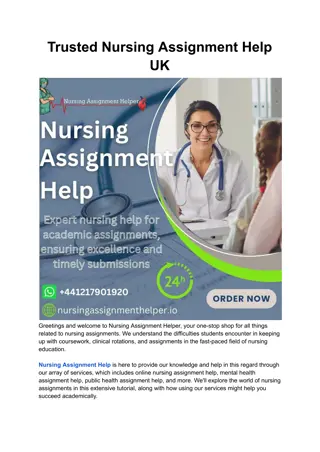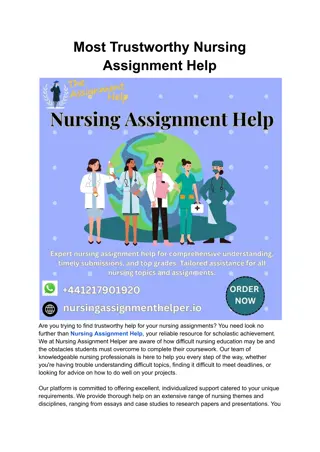Essential Information for Nursing Students
This comprehensive material covers topics vital for nursing students, including the importance of attending online sessions, graded homework, Medicaid, CNA responsibilities, nursing process, care plans, geriatrics, fall prevention, and bed rail safety. Stay informed to excel in your nursing education and practice.
Download Presentation

Please find below an Image/Link to download the presentation.
The content on the website is provided AS IS for your information and personal use only. It may not be sold, licensed, or shared on other websites without obtaining consent from the author.If you encounter any issues during the download, it is possible that the publisher has removed the file from their server.
You are allowed to download the files provided on this website for personal or commercial use, subject to the condition that they are used lawfully. All files are the property of their respective owners.
The content on the website is provided AS IS for your information and personal use only. It may not be sold, licensed, or shared on other websites without obtaining consent from the author.
E N D
Presentation Transcript
ONLINE Sessions are mandatory-you can be dropped from the class if you do not attend. Homework is graded after the due date. Thanks to those of you who get it in early.
Quiz Review Medicaid-Federal funds managed by each state AND some disabled people qualify. C.N.A. will never obtain written consent When do you need to: ask the nurse, consult the care plan, or act on your own? (can the nurse choose not to delegate a task to you?) Medical Record Care Plan...Kardex Flowsheet Explain what you are doing-protects YOU Function of saliva Coma vs Dementia
Review Continued What is the difference between the nursing process, care plan, and the care conference? Nursing process-method of planning care You are an important part of this! Care Conference-the meeting where the nursing process is used and the care plan is made- YOU CAN ATTEND Care Plan -written plan -Done by RN Why answer the home phone with only your name? Who can you share information with???
Chapter 11 There will be about 10 x as many 65-85 years olds by the 2020 census. Where do myths about aging come from? Pg 136 (quality of life, housing, abilities, activity, sex) Geriatrics VS Gerontology Housing Options
Chapter 12 Why would just calling someone by name be an problem for identifying a resident? (pg 156) ID bracelet, Photo ID, ID number, Date of birth, and full name MSDS Material Safety Data Sheets (pg 170) Oxygen use-Read pg 172 what are the cautions? DNR ALLERGY FALL RISK (page 180) Disasters: evacuation OR shelter in place
Chapter 13 FALLS-major cause of injuries in elderly, 1/3 fall each year Remember these 3 facts: 1. BED RAILS: Used as directed by the nurse and the care plan. (page 188) 2. Bedrail = restraint The person cannot get out of bed or cannot lower them without help. 3. MUST be needed to treat the person s medical symptoms-requires a doctors order Transfer belts and helping the falling person
Bed Rail Rules When using bedrails during bedside care for a resident who has bedrails as part of the orders- Lower the rail on the side you are giving care Raise it before changing sides Always lower the bed and put the rails in the correct position when you are finished. NEVER walk away from the bed with the bed raised.
Restraints: Are we keeping anyone safer by restraining them? What is a chemical restraint? (page 199)
Chapter 15 CLEAN DISINFECTED STERILE
Isolation precautions 1. Standard Precautions-pg 223-24 are used JUST IN CASE a disease causing organism is present and not known-so it is used with everyone. HIV and Hepatitis B started this. 2.TRANSMISSION BASED precautions are used when a KNOWN disease causing organism is present and these added precautions address that organism and how it is spread. Pg 226 HANDWASHING is still #1 way to prevent infection
Infection Control Vaccines provide immunity. So can the disease itself (titers) Transmission precautions can result in isolation for a client-minimize this as possible How do Hepatitis and HIV spread? Double bagging pg 234 Broken glass is never cleaned up by hands pg 237 Sterile Field FIRST then sterile gloves pg 241
Chapters 16 Good body alignment at all times Define positions: pg 250 Chair position page 252 17 Levels of dependence, types of transfers pg 256 Transfers, What is friction and shearing? Page 259 Dangling what is it and why do we do it? Pg 270 Strong side, weak side where does the wheelchair go? Pg 277
Short chapters: 18-The person s Unit or Room Page 296 What goes where??? Who decides? 19-Making a bed Know the layers of sheets-esp waterproof sheeting pg 306 Types of beds and when you make them pg 304 Carry clean and dirty linen away from your body. Never shake linen, clean or dirty Wear gloves and fold dirty linen away from you
Personal Hygiene/Grooming Oral Care-why for the unconscious Pg 327 what can go wrong? Denture care pg 329 Bathing and Massage Perineal Care-urethra and meatus pg 349-50 Hair Nail and Foot Care Clothing-dependent or injured arm pg 372
See you in 3 weeks! Quiz # 2 opens at noon on Friday the 19th- Sunday 21st at midnight. Module 3 opens that day too! Next online session Tuesday March 1st! Please call or email with any questions from the lessons watch your emails for reminders and for any commonly missed ideas before the quiz.
This work is licensed under a Creative Commons Attribution 4.0 International License. This workforce product was funded by a grant awarded by the U.S. Department of Labor s Employment and Training Administration. The product was created by the grantee and does not necessarily reflect the official position of the U.S. Department of Labor. The U.S. Department of Labor makes no guarantees, warranties, or assurances of any kind, express or implied, with respect to such information, including any information on linked sites and including, but not limited to, accuracy of the information or its completeness, timeliness, usefulness, adequacy, continued availability, or ownership. UAF HEART is an equal opportunity employer/program and auxiliary aids and services are available upon request to individuals with disabilities. This project received $2.5 million (27% of its total cost) from a grant awarded under the TAACCCT grants, as implemented by the U.S. Department of Labor s Employment and Training Administration.























